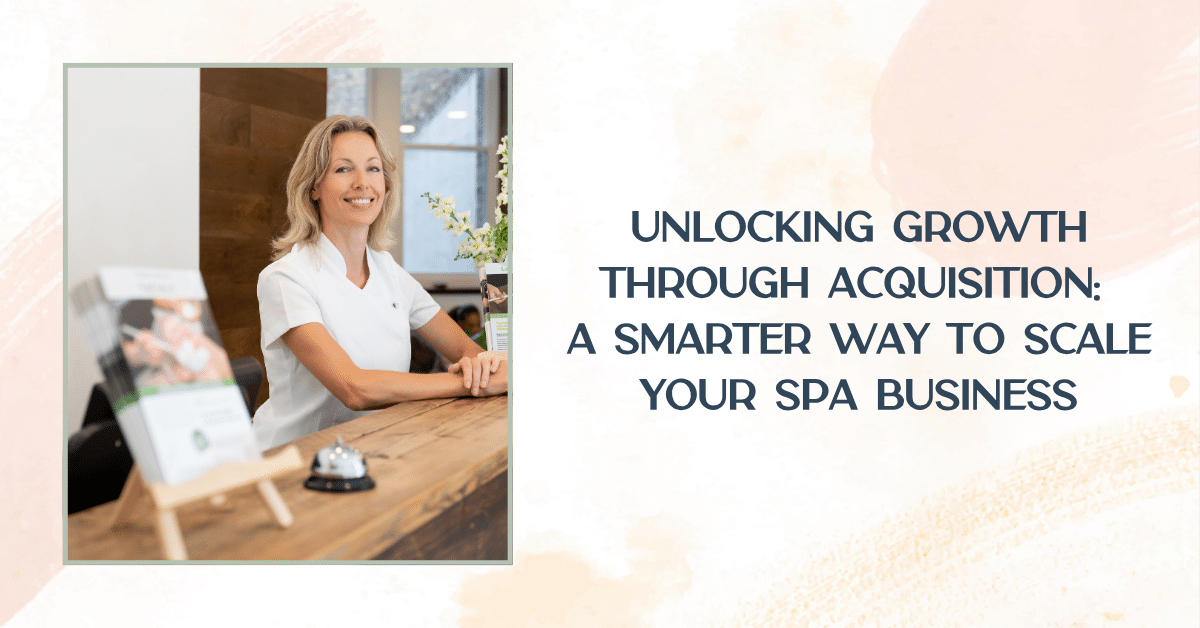When we think about growing our spa business, we often default to strategies like Google (SEO or paid ads), Instagram (organic and paid), or client referrals. And while these are all valuable, what if there was a faster, more strategic way to scale?
Private equity firms are rapidly investing in the spa and wellness industry. Their strategy? Acquisition. They’re buying up existing businesses rather than building from scratch. As independent spa owners, we can model this approach on a scale that makes sense to us.
Think about the number of solo aestheticians currently renting suites. Many of them love working hands-on with clients but eventually realize they don’t want to juggle all the responsibilities of running a business. They’ve built a client base, generating $50K, $60K, or even $100K per year, but the stress of wearing every hat leads many to close their doors.
Now, imagine creating a win-win scenario:
- The solo aesthetician walks away with extra cash for the hard work they’ve put into building their clientele.
- You, as the spa owner, not only acquire a built-in client base but also gain an experienced, fully booked provider who is paying for herself from day one.
This strategy allows you to expand without the slow, unpredictable process of attracting new clients one by one and the solo aesthetician gets to do what she loves in the treatment room with the bonus of some extra cash in her pocket.
How to Find & Purchase the Right Spa for Growth
1. Identify the Right Opportunity
Not every spa is a good investment. When evaluating potential spas, consider:
- Location – Is the spa close enough to your spa that the clients would easily transition to your location?
- Market Position – Does the spa cater to your target demographic or add a service your clients have been asking for.
- Reputation – Research online reviews and community perception.
2. Conduct Preliminary Due Diligence
Before making an offer, gather as much information as possible about the spa’s business health. I suggest starting by actually going and receiving services from solos in suites near you. Take note of how they are treating you, how they follow up with you, and how the service was.
Once you find a solo you think would be a good fit, plant the seed. Remember this person has spent much time and energy pouring into their business. Most likely they will not say yes right away. This is where building the relationship is essential. And be prepared to receive a lot of no’s before you get to a yes.
When you do finally get to a yes, you’ll want to do what is called due diligence. It’s common to sign an NDA at this point as well.
Focus on these areas:
- Financial Health – Request profit and loss statements, tax returns, and balance sheets from the last 3-5 years.
- Client Base – Analyze client retention rates and membership data.
- Operations – Review employee contracts if there are any, vendor relationships, and operational systems.
- Legal Standing – Ensure compliance with local licensing, zoning, and regulatory requirements.
💡 Pro Tip: I highly recommend working with a financial advisor or accountant to verify the accuracy of the seller’s financial data. I would also bring in an attorney to support you throughout this process.
3. Make an Offer
Once you’ve found a spa that aligns with your goals and it passes initial due diligence, it’s time to make an offer. Your offer should include:
- Purchase Price – The amount based on the spa’s valuation. This is usually net profit multiplied by 2 or 3 but your attorneys and accountant can help you come to a price you feel comfortable with.
- Terms and Conditions – Any contingencies, such as financing approval or a clean legal review. You’ll also need to determine if this will be an asset sale or stock sale – again, something your attorneys and accountants can support you with.
- Timeline – The proposed schedule for completing the transaction.
Negotiations often follow, so be prepared to adjust based on your findings.
4. Conduct Comprehensive Due Diligence
After your offer is accepted, conduct a deeper dive into the business. This includes:
- Financial Review – Verify cash flow, outstanding debts, and revenue trends.
- Asset Evaluation – Assess the condition of equipment, inventory, and lease agreements.
- Client & Staff Transition Plans – Ensure a smooth handoff to retain clients and employees. You may want to have a contract where the seller (the solo aesthetician) stays on as an employee of your spa for a minimum of one year.
- Legal Checks – Review all contracts, intellectual property, and potential legal disputes.
This stage is crucial for uncovering red flags or hidden liabilities that could impact the success of your acquisition.
5. Secure Financing
If you’re not purchasing the spa outright, explore financing options. Common methods include:
- SBA Loans – Small Business Administration loans are popular for acquisitions.
- Private Financing – Partner with investors or use personal funds.
- Seller Financing – Negotiate a payment plan directly with the seller, using the spa’s future profits to fund the acquisition.
📌 Key Insight: Seller financing is a powerful tool that allows you to acquire a business without traditional bank loans by using its existing revenue to fund the purchase. It’s still a good idea to give a deposit directly to the seller and then set out a schedule to pay them the remaining balance typically over a 3-10 year time period.
6. Close the Deal
Once financing is in place and all due diligence is complete, finalize the purchase. This involves:
- Signing the purchase agreement.
- Transferring ownership of assets and liabilities.
- Paying the agreed-upon purchase price.
💡 Pro Tip: Work with a lawyer to ensure all legal documents are in order and protect your investment.
Transition & Integration: Setting Up for Success
1. Plan the Transition
The acquisition doesn’t end at closing—it’s just the beginning. To ensure a smooth transition, focus on:
- Staff Integration – Introduce the seller (your new employee) with the existing team to address any concerns and share your vision. Normal onboarding and training should begin as well.
- Client Communication – Notify clients of the change in ownership and reassure them of your commitment to quality.
- Rebranding (if necessary) – If rebranding, do so gradually to maintain client loyalty.
- Operational Review – Audit current systems and processes to identify opportunities for improvement.
2. Overcoming Common Challenges
While acquiring a spa can be highly rewarding, it’s not without challenges:
🚨 Overestimating Value – Be realistic about the spa’s worth, especially if it needs significant upgrades.
⚖️ Cultural Misalignment – Ensure the spa’s values and service standards align with your vision.
📉 Client Drop-Off – Implement strategies to retain clients during the transition.
🛠 Integration Overwhelm – Avoid burnout by creating a step-by-step integration plan.
Final Thoughts: Is Spa Acquisition Right for You?
Purchasing a spa as part of your growth strategy is one of the most powerful ways to scale your business and accelerate financial success. By following this process—defining your goals, conducting due diligence, and planning a smooth transition—you can set yourself up for long-term profitability.
A successful acquisition isn’t just about the numbers—it’s about integrating the spa’s culture, staff, and clients into your vision. With careful planning and execution, your newly acquired spa could be the key to unlocking your next level of growth.
If this strategy piques your interest I highly recommend reading Main Street Millionaire: How to Make Extraordinary Wealth Buying Ordinary Businesses by Codie Sanchez. Codie is the founder of Contrarian Thinking, a media company that teaches in-depth how to build wealth through buying businesses. I highly recommend her teachings if this is a strategy that you plan to implement.
To connect with Addo Aesthetics, click the button below to learn about Addo Professional Association!

